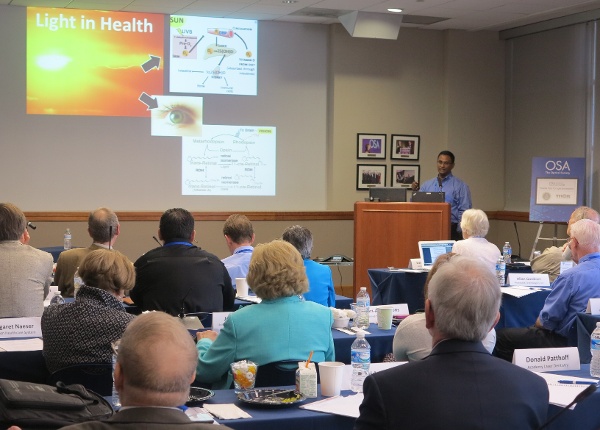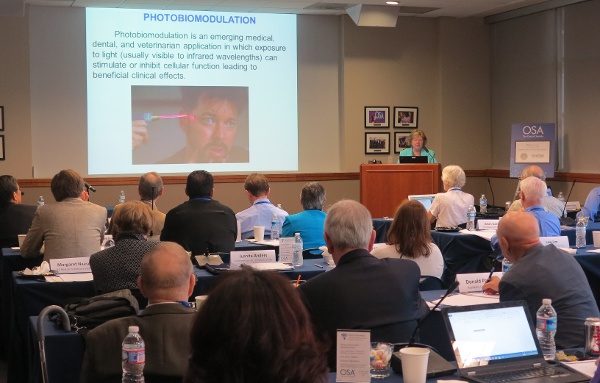Low Level Light Therapy: the Path Forward
Low Level Light Therapy: the Path Forward
Elieza Tang
The hosts of this Incubator are Juanita Anders, Uniformed Services University of the Health Sciences; Praveen Arany, National Institutes of Health; James Carroll, THOR Photomedicine Ltd; Michael Hamblin, Harvard Medical School; Donald Patthoff, DDS. The goals they identified for this incubator are to:
- Address the reasons why PBM has not been adopted into mainstream medicine
- Explore the science behind PBM
- Discuss the path forward by answering three critical questions
- What is real and what is not in the field?
- What is holding the field back?
- What is needed to move forward?
Bringing together expert researchers, clinicians, and industry representatives, this turned out to be a jam packed two day Incubator!
LLLT incubator attendees address reasons why LLLT is not widely adopted in mainstream medicine, on various levels, from the science standpoint as well as the standoint of the doctors, hospital administrators and insurance, and industry representatives and developmental professionals. Already the diverse experts in the room have had very open discussions on moving forward with LLLT.
After the brief introduction, we dove straight into the science and biological mechanisms session. Juanita Anders discussed the critical parameters for photobiomodulation, presenting a clear definition of PBM. PBM is an emerging medical, dental and veterinarian application which exposure to light can stimulate or inhibit cellular function leading to beneficial clinical effects. The key phrase here is the PBM encompasses both the stimulatory and inhibitory biological effects through a ‘bi-phasic dose response”. PBM, when used on a biological system, is not a limited or isolated event; there are a spectrum of downstream events that can occur. The important point is that tissue penetration is wavelength dependent. Different wavelengths have different depths of penetration and increasing the power of the laser will not alter tissue penetration depth. Overall Juanita presented three the critical parameters for PBM:
- Determine wavelength for depth penetration.
- Choose a wavelength to reach chromophores in target cells without being absorbed by other substances.
- Determine the appropriate dosage for target tissue. Juanita’s talk really provided some key points for discussion, by clearly identifying the need for well-defined parameters for the use of laser therapy in different injury models and that there are multiple factors to consider when determining appropriate laser treatment.
To continue, Praveen Arany’s talk presented a mechanism demonstrating that low power laser generates reactive oxygen species in a dose dependent manner activated latent TGF-β1 complex. The next step of his research was focused on the ability to use low power lasers to activate latent TGF-β, to direct differentiation of stems cells in dentin biology. The clinical application of his study was to promote stem cells in the tooth to produce dentin, which could be an alternative treatment option to having a root canal procedure. The most important point of Praveen’s talk is that he presents a clear biological mechanistic pathway, explaining how photobiomodulation stimulates cellular and biological processes using in-vitro and in-vivo models along with clinical studies. His research is evidence that supports the “hard science” of PBM use and makes a clear argument for PBM as an attractive treatment modality in the clinical setting.
Michael Hamblin wrapped up the basic mechanisms session focusing on cytochrome c oxidase, reactive oxygen species, and activation of transcription factors. He discussed a variety of laboratory studies that demonstrates the efficacious use of PBM in improving arthritic pain, excisional wound healing and reducing oxidative stress in primary cortical neurons using various mouse models. His studies provide evidence for the how and why LLLT should be more accepted in the medical community.
This session was followed by a lively group discussion with topics ranging from power and its relationship to heating and thermal profiles to cytochrome c oxidase, and the “spillover” effect that can occur with PBM. This Incubator is off to a great start, stay tuned here for further details.

Praveen Arany, National Institutes of Health.

Juanita Anders, Uniformed Services University of the Health Sciences
